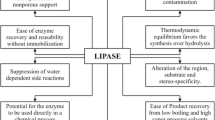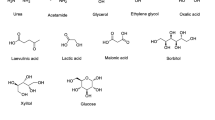Summary
The influence of solvents on enzymatic activity and stability was investigated. As a model reaction the α-chymotrypsin-catalyzed esterification of N-acetyl-l-phenylalanine with ethanol was used. The enzyme was adsorbed on porous glass beads and used in various solvents. Small amounts of water were added to increase the enzymatic activity. These enzyme preparations obeyed. Michaelis-Menten kinetics. K m,app decreased slightly with the log P value of the solvent while V app increased markedly with the log P value. Log P values were also useful for generalizing the influence of solvents on enzyme stability. The enzyme preparations showed a markedly higher thermostability in dry solvents having log P values >0.7 than in less hydrophobic solvents.
Also the operational stability was better in the more hydrophobic solvents. The amount of water added to the enzyme preparations greatly influenced the initial reaction rates. For some solvents optimal water contents were determined. The thermostability decreased with increasing water content.
The observations are summarized in the conclusion that more hydrophobic solvents are preferable to less hydrophobic ones. The log P value gives a good guidance when selecting an organic solvent for enzymatic conversions.
Similar content being viewed by others
References
Antonini E, Carrea G, Cremonesi P (1981) Enzyme catalysed reactions in water-organic solvent two-phase systems. Enzyme Microb Technol 3:291–296
Bell G, Todd JR, Blain JA, Patterson JDE, Shaw CEL (1981) Hydrolysis of triglyceride by solid phase lipolytic enzymes of Rhizopus arrhizus in continuous reactor systems. Biotechnol Bioeng 23:1703–1719
Brink LES, Tramper J (1985) Optimization of organic solvent in multiphase biocatalysis. Biotechnol Bioeng 27:1258–1269
Buckland BC, Dunnill P, Lilly MD (1975) The enzymatic transformation of water-insoluble reactants in nonaqueous solvents. Conversion of cholesterol to cholest-4-ene-3-one by a Nocardia sp. Biotechnol Bioeng 17:815–826
Cambou B, Klibanov AM (1984) Preparative production of optically active esters and alcohols using esterase-catalyzed stereospecific transesterification in organic media. J Am Chem Soc 106:2687–2692
Cremonesi P, Carrea G, Ferrara L, Antonini E (1975) Enzymatic preparation of 20β-hydroxysteroids in a two-phase system. Biotechnol Bioeng 17:1101–1108
Dastoli FR, Musto NA, Price S (1966) Reactivity of active sites of chymotrypsin suspended in an organic medium. Arch Biochem Biophys 115:44–47
Duatte JMC, Lilly MD (1980) The use of free and immobilized cells in the presence of organic solvents: the oxidation of cholesterol by Nocardia rhodochrous. Enzyme Engineering, 5. Plenum Press, New York, p 363–367
Harbron S, Smith BW, Lilly MD (1986) Two-liquid phase biocatalysis: epoxidation of 1,7-octadiene by Pseudomonas putida. Enzyme Microb Technol 8:85–88
Hilhorst R, Spruijt R, Laane C, Veeger C (1984) Rules for the regulation of enzyme activity in reversed micelles as illustrated by the conversion of apolar steroids by 20β-hydroxysteroid dehydrogenase. Eur J Biochem 144:459–466
Kawamura Y, Nakanishi K, Matsuno R, Kamikubo T (1981) Stability of immobilized α-chymotrypsin. Biotechnol Bioeng 23:1219–1236
Klibanov AM, Samokhin GP, Martinek K, Berezin IV (1977) A new approach to preparative enzymatic synthesis. Biotechnol Bioeng 19:1351–1361
Klyosov AA, Van Viet N, Berezin IV (1975) The reactions of α-chymotrypsin and related proteins with ester substrates in non-aqueous solvent. Eur J Biochem 59:3–7
Laane C, Boeren S, Vos K (1985) On optimizing organic solvents in multi-liquid-phase biocatalysis. Trends Biotechnol 3:251–252
Macrae AR (1985) Interesterification of fats and oils. In: Tramper J, van der Plas HC, Linko P (eds) Biocatalysts in organic synthesis. Elsevier, Amsterdam, pp 195–208
Manecke G, Beier W (1983) Immobilisierung von Corynebacterium simplex durch Photovernetzung von vinyliertem Polyvinylalkohol zur mikrobiologischen Steroidumwandlung. Angew Makromol Chem 113:179–202
Martinek K, Semenov AN, Berezin IV (1981) Enzymatic synthesis in biphasic aqueous-organic systems. I. Chemical equilibrium shift. Biochem Biophys Acta 658:76–89
Omata T, Tanaka A, Fukui S (1980) Bioconversions under hydrophobic conditions: effect of solvent polarity on steroid transformations by gel-entrapped Nocardia rhodocrous cells. J Ferment Technol 58:339–343
Ooshima H, Mori H, Harano Y (1985) Synthesis of aspartame precursor by solid thermolysin in organic solvent. Biotechnol Lett 7:789–792
Playne MJ, Smith BR (1983) Toxicity of organic extraction reagents to anaerobic bacteria. Biotechnol Bioeng 25:1251–1265
Reese ET, Mandels M (1958) Enzyme action on partition chromatographic columns. J Am Chem Soc 80:4625–4627
Rekker RF (1977) The hydrophobic fragmental constant. Elsevier, Amsterdam
Sonomoto K, Tanaka A, Omata T, Yamané T, Fukui S (1979) Application of photo-crosslinkable resin prepolymers to entrap microbial cells. Effects of increased cell-entrapping gel hydrophobicity on the hydrocortisone Δ′-dehydrogenation. Eur J Appl Microbiol Biotechnol 6:325–334
Takahashi K, Nishimura H, Yoshimoto T, Okada M, Ajima A, Matsushima A, Tamaura Y, Saito Y, Inada Y (1984) Polyethylene glycol-modified enzymes trap water on their surface and exert enzymic activity in organic solvents. Biotechnol Lett 6:765–770
Tramper J, van der Plas HC, Linko P (1985) Biocatalysts in organic synthesis. Elsevier, Amsterdam
Vanek T, Vankova R, Turkova J, Veruvic B, Kubanek V (1984) Enzymatically catalyzed esterification in nonaqueous media—part IV. Third Eur Cong Biotechnol. Preprints I:363–370
Wilkinson GN (1961) Statistical estimations in enzyme kinetics. Biochem J 80:324–332
Zaks A, Klibanov AM (1984) Enzymatic catalysis in organic media at 100°C. Science 224:1249–1251
Zaks A, Klibanov AM (1985) Enzyme-catalyzed processes in organic solvents. Proc Natl Acad Sci USA 82:3192–3196
Author information
Authors and Affiliations
Rights and permissions
About this article
Cite this article
Reslow, M., Adlercreutz, P. & Mattiasson, B. Organic solvents for bioorganic synthesis. Appl Microbiol Biotechnol 26, 1–8 (1987). https://doi.org/10.1007/BF00282141
Received:
Issue Date:
DOI: https://doi.org/10.1007/BF00282141




